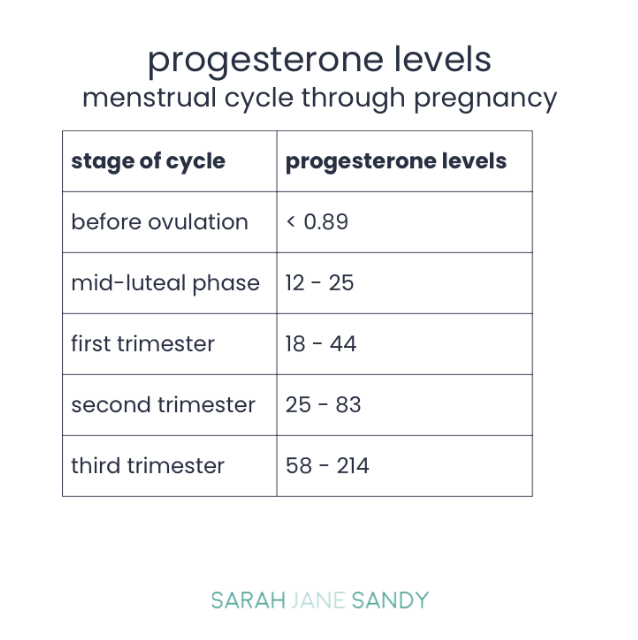

Using bioidentical progesterone can be extremely helpful for supporting low progesterone levels in the body.
Last week was all things progesterone—the role it plays in fertility, symptoms of progesterone deficiency, and how you can naturally support progesterone production. Today I’m going to take it one step further to tell you why and how you should use bioidentical progesterone cream to naturally increase your progesterone levels.
Bioidentical progesterone is the identical hormone that is produced by a woman’s ovary. It is made from naturally occurring plant steroids found in the wild yam. It is NOT the synthetic version that is used in oral contraceptives (progestins) or as the common prescription, Provera.
Synthetic progestins, like Provera or medroxyprogesterone, can produce severe side effects including increased risk of cancer, abnormal menstrual flow, fluid retention, nausea, depression and can even increase the risk of heart disease and stroke.
Side effects are extremely rare with natural progesterone. The only one of concern is that it can potentially alter the timing of your menstrual cycle.
Natural progesterone is very useful to balance excess estrogen which can be a major risk for breast cancer. Natural progesterone can also be used by the body as a precursor or starting material to make other hormones such as adrenal hormones. It can even convert it into estrogen or testosterone if your body needs it.
Natural progesterone is used for a variety of reasons including:
There is also research and medical theory indicating the appropriate balance of progesterone:
Progesterone, which plays a crucial role in brain function, is often called the “feel good hormone” because of its mood-enhancing and antidepressant effects.
Patients who complain about anxiety and irritability often notice that a corrected balance of progesterone vastly reduces or eliminates these feelings.
Four benefits of using natural progesterone:
1. Natural progesterone helps to balance estrogen levels, reducing symptoms of estrogen dominance such as heavy or irregular periods, PMS, fibrocystic breasts, and mood swings. By supporting the luteal phase of the menstrual cycle, it also prevents disruptions and stabilizes overall cycle length.
2. Progesterone is known for its calming effects on the brain due to its role as a neurosteroid. It interacts with GABA receptors, producing an anti-anxiety effect, enhancing mood stability, and supporting better sleep quality. Studies have shown it may also have neuroprotective effects, reducing risks of neurodegenerative diseases and helping to repair nerve damage.
3. Natural progesterone plays a critical role in bone health by stimulating bone formation and increasing osteoblast activity (cells responsible for bone building). Unlike synthetic progestins, which do not offer the same protective benefits, natural progesterone has been shown to help reduce the risk of osteoporosis, particularly in postmenopausal women.
4. Progesterone supports metabolic health by enhancing thyroid hormone action, regulating insulin sensitivity, and supporting proper fat metabolism. It helps counteract estrogen’s suppressive effect on thyroid function, leading to better energy levels, improved metabolism, and reduced risk of weight gain.
While a progesterone pill may be considered easier to take, studies have shown that upwards of 90% of the oral dose is lost through the liver. You’d need to take an oral dose that is 500% higher than what you need to make an impact. Another consequence of taking oral progesterone is that over 30 different metabolites (the chemical components that result when your liver metabolizes a substance) are created in your liver after you take progesterone by mouth—any of these can then have unwanted side effects.
If nature had intended to locate your ovaries in your stomach or somewhere else in your GI tract it might make sense for women to swallow progesterone. But since your ovaries are not connected to your GI tract at all, it’s more effective to get the progesterone as close to your ovaries as possible, via your vaginal canal. Your ovaries have direct access to your bloodstream through a pelvic plexus of veins, which delivers their hormone secretions to your heart which in turn pumps them, unchanged, to hormone-sensitive cells throughout your entire body.

To get a baseline of where your progesterone levels are currently at, I always suggest testing first. You can either order an at-home Comprehensive Hormone Panel where you will collect saliva + blood spot samples at home in your luteal phase OR you can request a blood progesterone level from your doctor 6-8 days after your confirmed LH surge. We want to see serum progesterone levels ideally above 12 (I like to see them above 15) in the luteal phase to confirm optimal progesterone levels.
If your progesterone levels are lower than optimal in the luteal phase (less than 15 ng/mL), you have a couple of options for using bioidentical progesterone. Ideally, progesterone oil should be applied and absorbed vaginally. Absorption of progesterone through the mucous epithelial membranes of your labia is much more effective than through skin.
I always recommend using a bioidentical progesterone oil or a prepared vaginal suppository (such as the prescriptions Endometrin or Prometrium), versus using a progesterone cream.
If you apply or insert bioidentical progesterone to the mucous epithelial membranes that line your uterus and vagina, you obtain a virtually ideal administration system. Not only is absorption through these membranes more complete than through your skin, but hormones absorbed through your vaginal membranes enter the very same pelvic plexus of veins that your ovaries normally empty into.
From here the hormones are carried to your heart and lungs and distributed to your tissues just as if your ovary had actually produced them.
I recommend the BioMatrix Pro-Adapt progesterone oil, or asking your doctor to prescribe either Endometrin or Prometrium bioidentical vaginal suppository progesterone. You will start using the progesterone 3 days after you’re confirmed an LH surge. If you are not ovulating or not cycling, you will want to start using the progesterone on cycle day 15.
When it comes to dosage, more is not better. Too much progesterone may cause hormonal imbalances, just like too little progesterone can.
For most premenopausal women the usual dose is 40-100 mg/day for the two weeks before expected menses, stopping the day or so before menses. Progesterone use should begin directly after ovulation and end once menstruation begins (unless you’re trying to conceive).
I recommend that women track ovulation using an Ovulation Predictor Kit (such as the Mira tracker) so that you know the best day to begin progesterone use. Once you confirm an LH peak, begin using progesterone 3 days later. If you don’t notice ovulation by cycle day 18, then begin progesterone use. This means you’ve had an anovulatory cycle and you definitely need progesterone support.
Here’s how to use BioMatrix Pro-Adapt:
I also recommend that women track their menstrual cycle with a fertility app or other tracking tools so you can keep track of when you’re supposed to start your cycle and can stop progesterone appropriately.
If you are NOT trying to conceive, then you should stop progesterone when you begin to menstruate or the day you expect to get your period, whichever comes first.
If you ARE trying to conceive, make sure you continue using progesterone until you know if you are pregnant or not. If you are pregnant, CONTINUE using progesterone (see more information on this below). If you are absolutely sure that you are not pregnant, then you can discontinue progesterone to trigger your natural menstrual cycle—the abrupt lowering of your progesterone level is the primary stimulus for your period to start.

A loading dose of progesterone is beneficial in women who have had many months (or years!) of anovulatory (or no ovulation) cycles. Going this long without ovulating can lead to extreme progesterone deficiency. For each cycle that passes without ovulation, estrogen dominance becomes more likely as your progesterone stores are depleted. For more details on symptoms of progesterone deficiency vs estrogen dominance, see The Role that Progesterone Plays in Fertility.
In cases like this, a loading dose is recommended. Essentially, a higher dose of progesterone is used for one to two months, before going back down to a regular dose. A loading dose requires 40mg twice a day, one 40mg application in the morning and one 40mg application in the evening, for a total of 80mg of natural progesterone a day. Apply for two weeks before your period (starting on cycle day 15), up until menstruation begins.
Low progesterone while trying to get pregnant can be a cause of recurrent miscarriages. Progesterone creates a healthy environment in the womb by maintaining the uterine lining. It also reduces the chances of blood clots and the immune system responding to the fetus as if it was a foreign substance. Using progesterone cream during and throughout pregnancy can help you maintain and sustain a full-term pregnancy.
Under the care of a doctor or midwife, natural progesterone use can prevent first trimester miscarriage (when the primary cause is low progesterone). By the second trimester, the placenta itself is responsible for producing progesterone, so you can stop using the progesterone (again, under the care of a doctor or midwife).
Estrogen dominance may become worse when you first start using progesterone. After an extended period of progesterone deficiency, your estrogen receptor sites will be stimulated by the use of progesterone cream. This is a good sign though! It means that your body is responding well to the progesterone. It may take a few cycles of experiencing estrogen dominance symptoms—breast tenderness and swelling, spotting, fluid retention, hot flashes, fatigue, etc.—before your progesterone levels regulate.
Progesterone should be not be quit cold turkey. It’s important that you gradually wean yourself off of it by slowly reducing the amount each time you use it. This should be done on the last cycle that you plan on using it. If you are pregnant, do not do this until the end of the 12th week of gestation, when the placenta takes over progesterone production.
A severe progesterone deficiency will require significantly longer progesterone supplementation to regulate your levels. It can take anywhere between 4-12 months for women with extreme progesterone deficiency to see results. Following a loading dose protocol may help to bring the levels up quicker, but consistency of use over an extended period is best.
Splitting the dosage between AM and PM. Splitting the dosage ensures 8-12 hours of sustained delivery – which more closely mimics how your body produces progesterone. If you do one big dose in the morning, and nothing in the evening, you are risking a full 12 hours of no progesterone absorption. If you find progesterone makes you really sleepy, you can take the full daily dose in the evening before bed.
Diet and lifestyle tweaks, targeted supplementation, exercise and weight management, cleaning up your environment, stress reduction, and the use of bioidentical progesterone are all natural ways to increase your progesterone levels. To dig deeper into each of those topics, see my blog post titled ‘Balanced living with a hormone imbalance: low progesterone edition’.
Step one is to get a baseline of where your progesterone levels are currently at through testing. We want to see serum progesterone levels ideally above 12 (I like to see them above 15) in the luteal phase to confirm optimal progesterone levels.
Ideally, progesterone should be applied and absorbed vaginally—absorption of progesterone through the mucous epithelial membranes of your labia is much more effective than through skin.
Dosage and timing are all dependent on where your progesterone levels are currently, and what your goals are—whether you’d like to get pregnant or not, or if you’re trying to manage symptoms of low progesterone,
This table gives you a good idea of where your progesterone levels should be during each phase of your cycle:

The Fertility Code is the best-kept secret of women who want to take the guesswork out of conceiving, and give themselves every possible chance of getting, and staying, pregnant successfully.
Bringing together a personalized & custom approach, evidence-based information, science-backed protocols, and nurturing practices, this course is for anyone who is struggling to get pregnant, or thinking about getting pregnant soon. The course is a one-stop-shop for getting your body, mind and soul prepared for conception.
In less than 3 months, you will learn exactly what you need to do now to get pregnant successfully and have a healthy full term pregnancy with The Fertility Code.
Sarah Jane Sandy is a certified nutrition therapist, and a fertility and women’s health expert. She has helped hundreds of women increase their fertility naturally and go on to have healthy full-term pregnancies. She has been working with women and couples trying to get pregnant for over 16 years and over 90% of the women who work with her get pregnant and have healthy babies.
She also works with women trying to fix their hormone imbalances, as well as supporting women through pregnancy and the postpartum period. Learn more about her own fertility and hormone journey here. To send Sarah a message, complete her Contact Form.

Curious about your fertility health? Take this simple quiz to find out what factors may be harming your fertility, and learn what you can do about it!